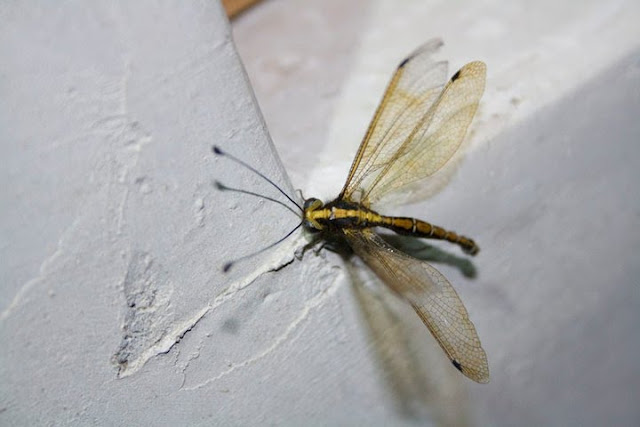
For as long as I can remember this killing field has been around at the same spot, sheltered under the arch of our ancestral home in Uttar Pradesh, northern India. The present colony sits on the mud collected between the wall of the arch and the road. What used to be a mud road running into the courtyard of the house was upgraded to a brick road and then to a tarred road, but the colony (not really a “colony” since the individuals have little to do with each other in a communal sense) has thrived. This minefield of inverted volcanoes has been home to several generations of antlions and its near permanence is testimony to their adaptation and survival instincts.
As kids this colony of antlions fascinated my brother and me endlessly. It was the place for macabre experimentation in complex predator-prey relationships fueled by both curiosity and frenzied betting (involving marbles for coveted currency), though not necessarily in that order. The basic level was to introduce a hapless ant in a selected pit and place bets on its fate. The antlion would indicate its presence by throwing up puffs of dust, almost as if the inverted volcano was erupting. It served to confuse the ant and collapse the steep pit slopes, blocking the ant’s escape. The ant would become absolutely still, perhaps sensing its fate. Then in sudden fateful and much anticipated moment it would vanish, pulled in by the still unseen predator. Bets involved both presence and capture; mostly they were both settled with the presence. Escape was rare.
Then there were the variations.
The next level was to catch the antlion by scooping off the entire pit just at it had grabbed the ant. We would then carefully sort through the mud and locate the guy – a tiny bug with menacing jaws (for its size) and otherwise, to our eyes, unremarkable. This tiny predator is actually the larva of the antlion, the next stage being the pupa which metamorphoses into a damselfly like adult. I have rarely seen any ants or small insects in the vicinity of the colony so the food supply is not really abundant but then I guess it does not need to eat a lot. The colony has always had pits of different sizes to suit the size of the larva and newer pits keep coming up, so by all means the colony is prospering.
Other game variations involved introducing more than one ant, ants of different sizes, and an especially morbid one where an antlion was introduced in another’s lair. The variations kept coming, fuelled by a steady supply of ants and helped along by weak incipient conscience and imaginative betting odds.
|
|
Close up, the antlion is a fierce-looking character. Wikipedia gives the following description, “The life cycle of the antlion begins with oviposition (egg-laying). The female antlion repeatedly taps the sand surface with the tip of her abdomen. She then inserts her abdomen into the sand and lays an egg. The antlion larva is a ferocious-appearing creature with a robust, fusiform, a very plump abdomen the thorax bearing three pairs of walking legs. The prothorax forms a slender mobile “neck” for the large, square, flattened head, which bears an enormous pair of sicklelike jaws with several sharp, hollow projections. The jaws are formed by the maxillae and mandibles, which in each pincer enclose a canal for injecting venom between them. Depending on species and where it lives, the larvae will either hide under leaves or pieces of wood, in cracks of rocks, or dig pits in sandy areas. Antlion larvae are unusual among the insects as they lack an anus. All the metabolic waste that is generated during the larval stage is stored and is eventually emitted as Meconium near the end of its pupal stage.”
Antlions belong to the insect family Myrmeleontidae comprising about 2,000 species. I have encountered them in several locations especially below rock outcrops (quite a number are to be found in Ramanagaram near Bangalore).
|
|
While the larval stages may last 2-3 years based on the food supply, thedamselfly-like adult with transparent wings (an effective camouflage since during the day it lies motionless) lives for about a month alone. Its main job is reproduction. That achieved, it dies. It must wait for a few minutes after emerging from the cocoon (emergence is mainly at dusk) for its wings to expand and toughen but it is never a very good flier — compared to dragonflies and damselflies. The adult is mainly active at dusk and the usual wingspan is 8 inches but can reach up to 16 cm in the African genusPalpares. The body length is typically 4 cm.
The website Antlion Pit has this interesting bit of information on the antlion being host to another species: “Of the documented relationships between antlions and other animals, perhaps the most interesting is the relationship in which antlion larvae serve as hosts to parasitic insects. For example, the larvae of the Australian horsefly (Scaptia muscula) live inside antlion larvae pits, where they share the spoils of the antlions’ trapping abilities”.
This year, as I introduced my son to this master predator, I realized I had lost a fair amount of skills in dealing with them. It was time for him to take over but he seemed reluctant. My wife attributes it to a more evolved conscience; I privately disagree and am convinced that it has to do with lack of appropriate betting stimuli.
|
|
Antlion larva photograph courtesy of Wikimedia Commons
- Encounter: The Sacred Grove at Oorani - November 28, 2012
- Encounter: Rhododendron, sentinel of the highlands - October 7, 2012
- Manjhi Akshayavat, an immortal Banyan tree - July 17, 2012




